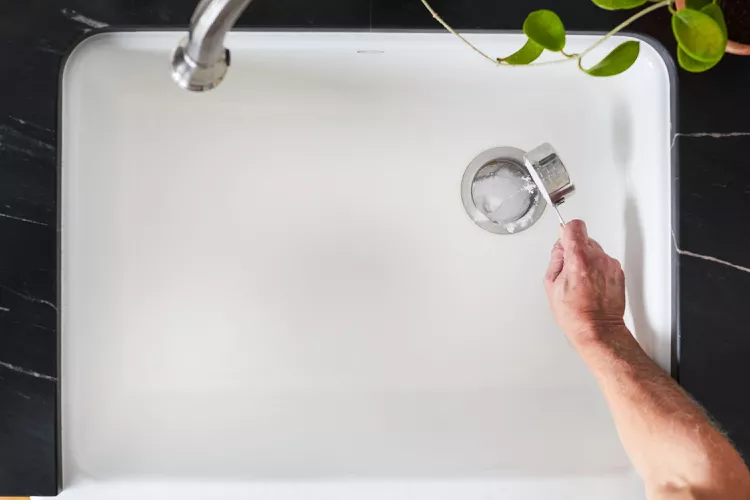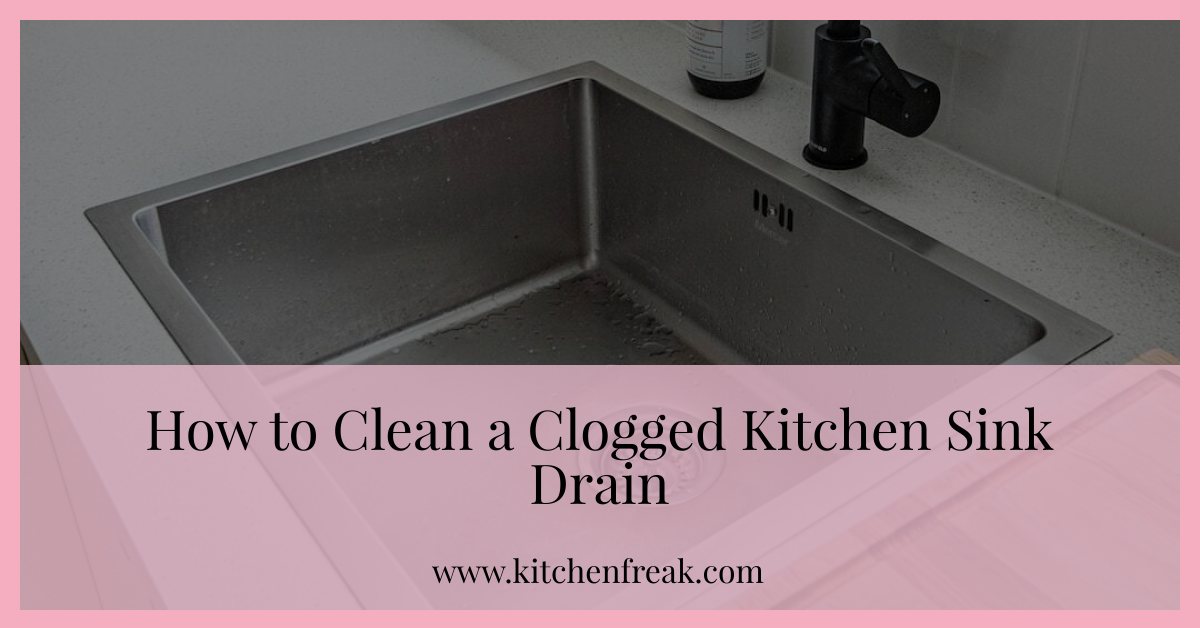We clean our kitchen daily. that’s a truth but what about the kitchen sink and drain? Let me be very honest, we often ignore to clean the kitchen sink. After all, we wash our dishes in the sink and rinse it afterwards, so it stands to reason that we might be cleansing the sink as we go. However, this little act of carelessness might result in a smelly clogged drain.
Your kitchen sink becomes dirty from washing plates, pots, and pans in the same way as bathtubs and showers do from cleaning our bodies. A dirty film is left on your sink from grime, food crumbs, and other debris, which serves as a breeding ground for germs and mold. Gross! That kitchen sink is how filthy? The typical kitchen sink is more contaminated with bacteria, dirt, and waste than a flushed loo! As a result, your kitchen sink may be the dirtiest spot in your house. However, let’s not freak you out more and get to the point!
Follow these quick tips that will help you in Cleaning Kitchen Sink Drain:
Table of Contents
Clean Your Kitchen Sink Drain with Boiling Water
If your kitchen sink is not fully clogged but the water goes down slowly, you can thoroughly clean it with hot boiling water.
Pour the water slowly and gently down the drain, being careful not to splash or spill any liquid. You’ve successfully removed the blockage if the water flows through the drain swiftly and easily.
Boiling water poured down the drain in the kitchen also aids in removing drain flies who lay their eggs in the accumulation inside your pipes.
How to Unclog Kitchen Sink Drain with Baking Soda
Do yo know that you can clean a clogged kitchen sink with just some baking soda and vinegar? I will tell you how we do it! Follow these easy steps to clean a kitchen sink drain using baking soda and white vinegar:
- Pour hot boiling water down the drain.
- Now sprinkle one cup of baking soda in the drain and after few minutes add a cup of white vinegar.
- Let the vinegar and baking soda mixture set for 30 minutes. The bubbling will do the magic.
- Rinse the drain with hot boiling water. Any residue clogging your drain will be melted away by the boiling water, allowing it to pass through your pipes.
- Boiling water poured down your kitchen drain will also assist in getting rid of drain flies and their eggs that are laid in the buildup within your pipes.
- Repeat this exercise once a week. This hack will keep your kitchen sink clean and fresh.
Moreover, you can also use store-brought drain cleaners or DIY drain cleaners for your kitchen.

How can I clean the drain opening of my kitchen sink?
To clean the drain opening of your kitchen sink, you can try the following steps:
- Start by removing any visible debris or hair that may be blocking the drain.
- Mix a solution of equal parts vinegar and baking soda.
- Pour the mixture down the drain and let it sit for about 30 minutes.
- Flush the drain with hot water to remove any residue.
- For stubborn clogs or buildup, you can use a drain snake to remove the blockage.
Regularly cleaning the drain opening can help prevent clogs and keep your kitchen sink drain flowing smoothly.
How to Clean Garbage Disposal
You can clean your garbage disposal with three simple ingredients: ice cubes, lemon slices and salt. Follow the following quick method to clean the garbage disposal:
Salt, ice cubes, and lemon slices should all be placed in your garbage disposal. Once the ice has melted, start your garbage disposal while the cold water is still running. The blades are scrubbed with salt, and any filth and grime is removed with ice. If you don’t have any coarse salt, try using rock salt or sea salt instead. which lemon? That serves to deodorize and, of course, produce a fresh scent.
How to clean smelly kitchen drains?
In order to avoid stinky kitchen drains, keep the garbage disposal cleaned. There are still few other methods to get rid of kitchen drain odors.
- Scrape food scraps from plates into the trash to prevent them from going down the drain. If you use a dishwasher, follow the same advice because food waste will also clog the pipes in that appliance.
- Keep fat and oil out of the sink. The solidification of cold fat will clog the drain.
- Let the boiling water running for more than one minute to clean the drain after washing the dishes.
How Often Do You Need To Clean the Kitchen Drain?
A minimum of once each month, you should clear the drain in your kitchen sink. By doing this, you can maintain it clean and odor- and bacteria-free. Every two weeks, rinse your waste disposal with citrus juice if you have one. By doing so, you’ll be able to get rid of food waste and avoid odors and germs.
If necessary, use a plunger to unclog clogged drains. Every three to six months, in addition to routine drain cleaning, a drain snake should also be used. This will assist in clearing up clogs caused by grease and other buildups in the drain pipes.
Recommended: How to Clean Kitchen Faucet Head
Use these tips to unclog a kitchen sink and let me know which trick worked well for you?
Cleaning Kitchen Sink Drain – FAQs
Q: What are some tips for keeping my kitchen sink clean and fresh?
A: To keep your kitchen sink clean and fresh, it’s important to regularly clean and maintain it. Here are some tips: – Rinse the sink thoroughly after each use. – Use mild cleaning products and avoid harsh chemicals that can damage your sink. – Clean a stainless steel sink with a microfiber cloth and a gentle cleanser. – Avoid leaving food particles or debris in the sink for extended periods of time. – Regularly clean your garbage disposal to prevent odors. – Use a bio-friendly drain cleaner if necessary. – Avoid pouring grease or oil down the drain, as they can cause clogs. – Consider using a sink strainer to catch food particles and prevent them from entering the drain.
Q: Can I use ice cubes to clean my kitchen sink drain?
A: Yes, you can use ice cubes to clean your kitchen sink drain. Simply fill your sink with two cups of ice cubes and a cup of rock salt, and then run cold water down the drain for a few seconds. The ice cubes and salt combination can help break up any buildup or residue in the drain and make it easier to flush out.
Q: How often should I clean my kitchen sink drain?
A: It is recommended to clean your kitchen sink drain at least once a month to prevent clogs and maintain proper drainage. However, if you notice any signs of a clog, such as slow draining water or unpleasant odors, you should clean the drain as soon as possible to avoid further issues.
Q: Can I use a drain snake to unclog my kitchen sink drain?
A: Yes, you can use a drain snake to unclog your kitchen sink drain. A drain snake is a long, flexible tool that can be inserted into the drain to break up or remove clogs. It is important to follow the manufacturer’s instructions and use the drain snake carefully to avoid damaging your pipes.
Q: What should I do if my kitchen sink drain is draining slowly?
A: If your kitchen sink drain is draining slowly, there are a few steps you can take to try and improve the flow. First, try pouring boiling water down the drain to break up any grease or debris. If that doesn’t work, you can try using a plunger to create pressure and dislodge the clog. If the clog persists, you may need to use a drain snake or call a plumber for further assistance.
Q: Can I pour chemicals down my kitchen sink drain to clean it?
A: While some chemical drain cleaners can be effective at removing clogs, they can also be harsh and damaging to your pipes. It is best to avoid using chemical drain cleaners if possible, especially for regular cleaning. Instead, opt for more natural and bio-friendly drain cleaners or try other methods, such as using vinegar and baking soda, to clean your kitchen sink drain.
Q: How can I learn how to clean a kitchen sink properly?
A: To learn how to clean a kitchen sink properly, you can follow these steps:
- Rinse the sink with hot water to remove any loose debris.
- Apply a small amount of mild cleanser or dish soap to a sponge or microfiber cloth.
- Scrub the sink in a circular motion, paying special attention to any stains or spots.
- Rinse the sink thoroughly to remove any soapy residue.
- Dry the sink with a clean cloth to prevent water spots or streaks.
- For difficult stains, you may need to use a gentle abrasive cleaner or a mixture of baking soda and water. Remember to always read and follow the manufacturer’s instructions for cleaning products and avoid using harsh chemicals that can damage your sink.
Q: Why is my kitchen sink drain clogged?
A: Kitchen sink drains can get clogged due to a variety of reasons including food debris, grease buildup, hair, or foreign objects. Regular maintenance can help prevent blockages.
Q: Can you pour bleach down a smelly drain?
A: While bleach can eliminate some odors and bacteria, it’s not always the best solution for a smelly drain. Over time, bleach can corrode pipes and harm septic systems. Instead, consider natural alternatives like a mixture of baking soda and vinegar followed by hot water to deodorize and clean your drain.
Q: Is it safe to put ice down your kitchen drain?
A: Yes, ice can help sharpen garbage disposal blades and assist in dislodging any stuck food particles. Running cold water while using the disposal with ice can be an effective cleaning method. However, always be cautious and ensure you don’t overload the disposal.
Q: What natural methods can I use to unclog a kitchen sink drain?
A: A mixture of baking soda followed by vinegar can create a fizzing reaction, helping to break down clogs. After letting it sit for about 30 minutes, pour hot water down the drain. This method is eco-friendly and safe for most drains.
Q: Is using a plunger effective for a clogged kitchen sink?
A: Yes, a plunger can be quite effective in clearing minor blockages. Make sure you have a good seal and apply firm, consistent pressure to help dislodge the clog.
Anum Basit, the organizing maven and cleaning aficionado behind KitchenFreak, is a devoted stay-at-home mom with a knack for turning chaos into calm. With a passion for writing and a decade of hands-on experience managing a busy household, Anum has cultivated a deep understanding of space utilization, effective cleaning techniques, and sustainable maintenance practices. Her home has become her laboratory, where she experiments with different strategies and shares her findings on her blog.
KitchenFreak began as a way for Anum to document her journey towards creating a clutter-free, easy-to-maintain, and clean kitchen. Today, it’s a go-to resource for fellow parents and homemakers seeking practical advice on kitchen organization, maintenance, and cleaning hacks.
Anum’s expertise isn’t confined to theory; it’s steeped in real-life trials, errors, and triumphs. From discovering the best ways to organize a pantry to finding child-friendly cleaning supplies, Anum’s advice comes from her lived experiences.
Through KitchenFreak, Anum aspires to help others uncover the joy of a well-organized kitchen. Her aim is to inspire, educate, and empower her readers, showing them that no matter how messy things may get, creating a spotless kitchen is possible, one step at a time.

